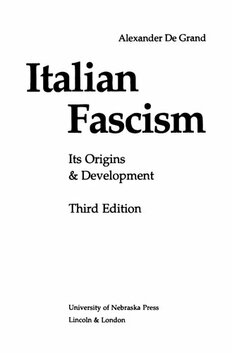
Italian Fascism: Its Origins and Development PDF
Preview Italian Fascism: Its Origins and Development
Alexander De Grand Italian Fascism Its Origins & Development Third Edition University of Nebraska Press Lincoln & London © 1982, 1989, 2000 by the University of Nebraska Press All rights reserved Manufactured in the United States of America © Library of Congress Cataloging-in-Publication Data DeGrand, Alexander. Italian fascism: its origins and development / Alexander DeGrand.— 3rd ed. p. cm. Includes bibliographical references and index. ISBN 0-8032-6622-7 (pbk.: alk. paper) 1. Fascism—Italy—History. 2. Italy—Politics and government— 1870-1914. 3. Italy—Politics and government—1914-1945. I. Title. DG571.D37 2000 320.53 '3 '0945—dc21 99-047948 To Linda and Alex ix Preface to the Third Edition xiii Preface Part One The Historical Background, 1870-1922 Chapter One 3 The Origins of Fascism, 1870-1918 Chapter Two 22 The Postwar Crisis and the Development of Fascism, 1918-22 Part Two The Fascist Regime in Ascendancy, 1922-35 Chapter Three 41 Between Movement and Regime, 1922-25 Chapter Four 58 The Creation of the Regime, 1926-29 Chapter Five 78 The Fascist Regime and the Great Depression, 1929-34 Chapter Six 92 Fascist Foreign Policy, 1922-35 Part Three The Downward Spiral, 1935-45 Chapter Seven 105 Fascism at War: Economy and Society, 1935-43 Chapter Eight 117 The Reorientation of Foreign Policy, 1936-43 Chapter Nine 130 The Italian Social Republic, 1943-45 Chapter Ten 138 The Political Culture of Fascism: Ideologies and Intellectuals Chapter Eleven 164 Conclusion 171 Bibliographical Essay 185 Index Preface to the Third Edition Curiously, the further historians get from the direct experience of fascism, the more seriously they take its pronouncements and as pirations. Since the first edition of this book in 1982 much work has been done on Fascist culture and the efforts of Mussolini's regime to reshape Italians through the formation of civic religion, manipulation of symbols, mass rallies, and the intrusion of the state into the private sphere. Yet, in some important ways, this book remains anchored in an earlier tradition that stressed eco nomic and social realities. What fascism did has always seemed to me more important than what it said it wanted to do. I remain quite skeptical about claims that fascism seriously remade Ital ians. The great economic, social, and ultimately political shift came later with the Italian economic miracle of the late 1950s and 1960s. That said, there is no doubt that fascism was one of the twentieth century's three great approaches to the challenge of organizing the new mass society that emerged at the end of the previous cen tury and exploded on the political scene after World War I. Lib eral democracy, an extension of nineteenth-century liberalism, continued to stress individual values and interests, which would be represented on the basis of geographical units (electoral dis tricts and colleges), and a plurality of parties and interest groups. By the early 1920s many doubted that such a system would be adequate to keep political society from fragmenting under the impact of the social and economic disruption produced by the Great War. Already in 1917 the Bolshevik revolution suggested an x Preface to the Third Edition alternative vision of solidarity and unity: the organization of mass society on the basis of one's status as worker or peasant. The class- based Bolshevik ideal not only negated liberal individualism but also other forms of solidarity, such as the nation or race. How ever, national and racial solidarity formed the core of a third al ternative way of organizing mass society. Unity would be imposed, but it would be on the basis of extreme nationalism (fascism) or racism (nazism). A national or racial myth would be the binding ideological glue that would hold society together. As Roger Grif fin and others have pointed out, a myth of national or racial re birth would offer to society a chance to rise out of the crisis, de cline, and social fragmentation that menaced Europe after World War I by beginning anew (The Nature of Fascism [London: Rout- ledge, 1994], chapter 2). Europeans during the period from the end of World War I to the outbreak of World War II were preoccupied, even haunted, by a quest for unity and fear of disintegration. The idea that things were coming apart, that some basic mechanism in western civili zation had broken down, and that only revolutionary change or heroic measures could set things right again dominated politics on both left and right. Fear that "the center would not hold" led many to search for all-embracing total solutions. To this extent fascism proposed, at least in theory, a totalitarian vision of the future. In chapter 10 and the conclusion of this third edition of Italian Fascism I will attempt to come to terms with recent approaches to understanding fascism. But this book remains faithful to its origi nal premise that behind the facade of totalitarismo the Italian fas cist regime remained politically, economically, culturally, and ideo logically fragmented in a series of competing fiefdoms and interest groups. Only by looking at the maneuvers and compromises be hind the distribution of power within the Fascist system can one understand the failure to impose a truly unitary vision, the per sistence of competing versions of fascism, and the ultimate break down of the regime. A book of this sort would never have been written without the research of several generations of scholars who have shaped my
